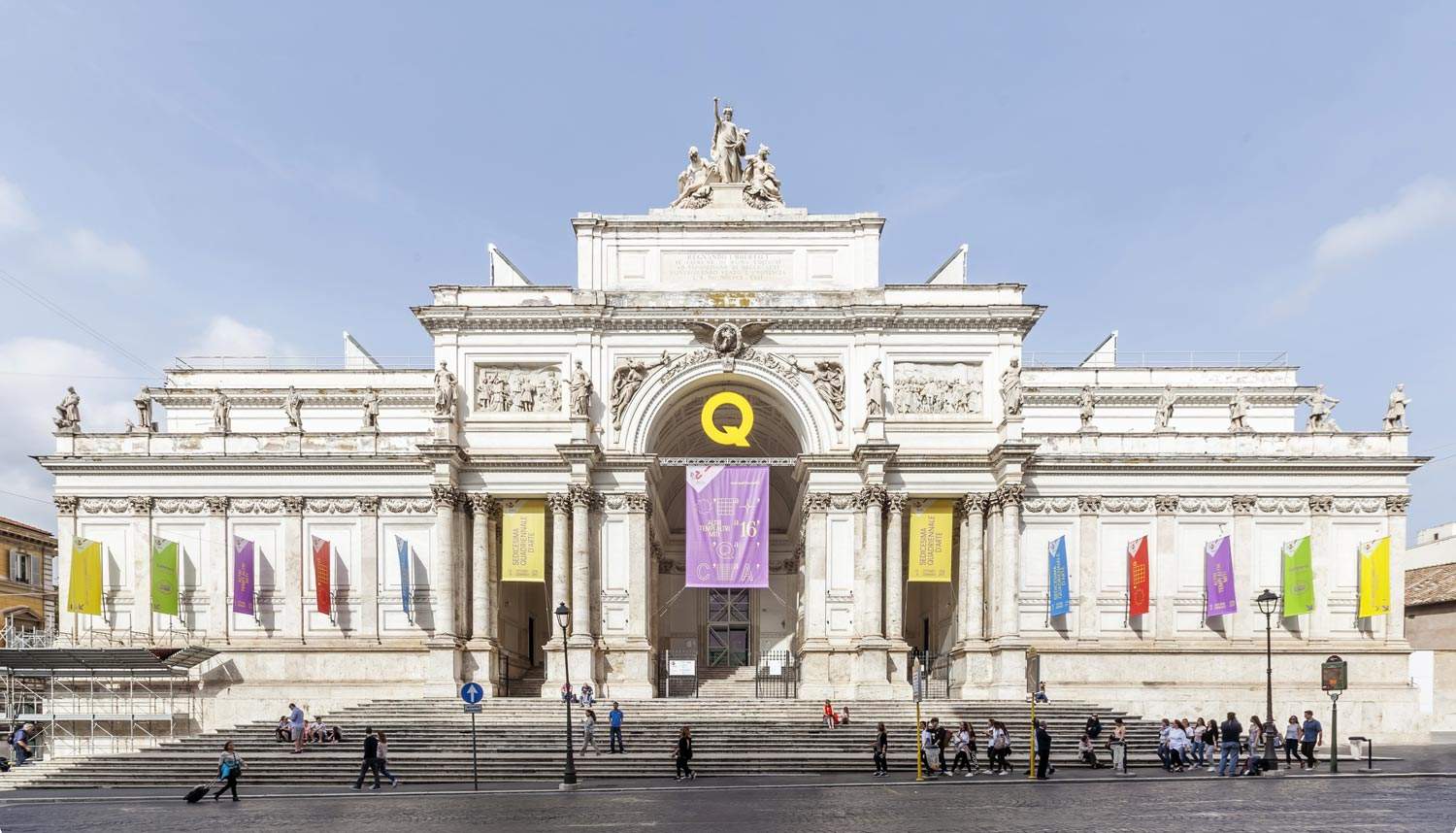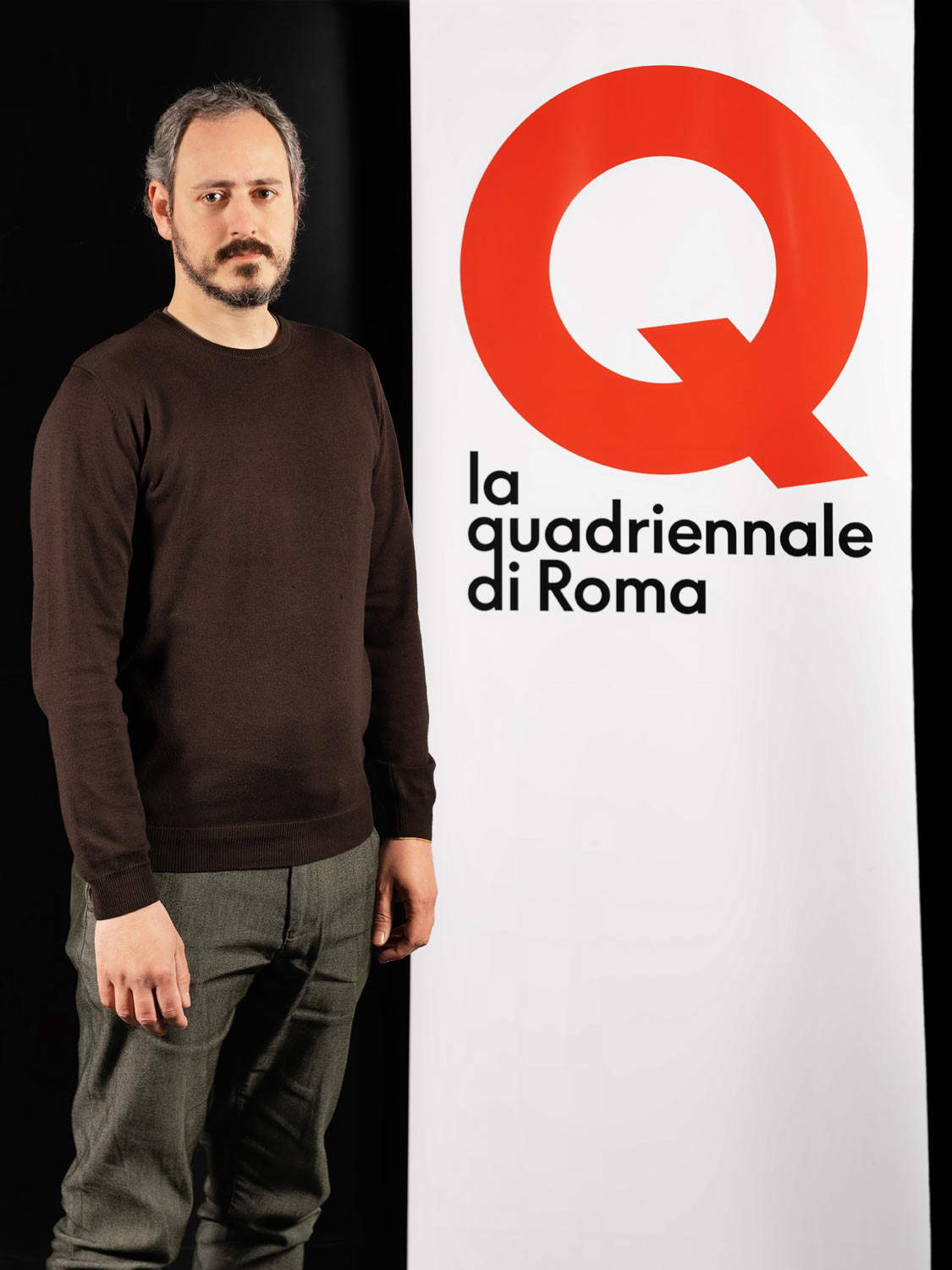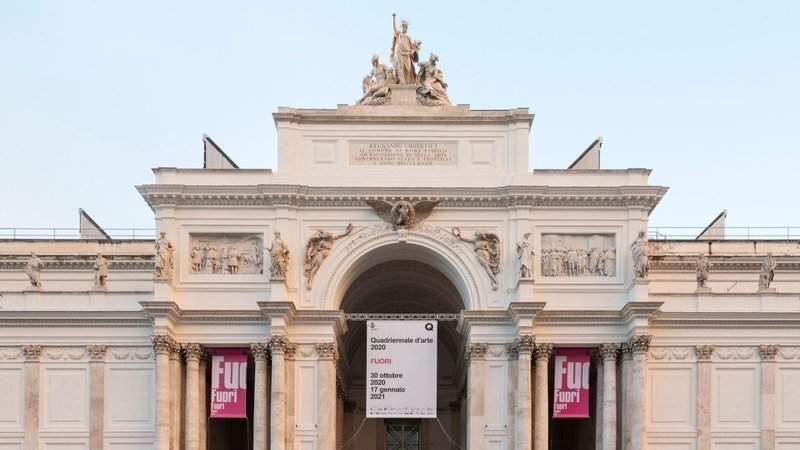Presented this morning in Rome the program for the three-year period 2022-2024 of the Fondazione La Quadriennale di Roma, conceived by new artistic director Gian Maria Tosatti. The program was presented by Tosatti and the foundation’s president, Umberto Croppi, on the occasion of the Quadrennial’s 95th anniversary (1927-2022), an anniversary that, the foundation noted, “coincides with a particular juncture in the life of the institution and gives impetus to the revision of its activities, in a logic of continuous renewal and expansion of the scope of its action.” The anniversary, in particular, provided a symbolic framework for the review of activities and the propulsive stimulus for the start of programming, whose projects of analysis, study, and promotion of Italian art of the 20th-20th centuries are developed in the first year and a half under its denominator.
After the Quadriennale d’arte 2021, the Foundation’s Board of Directors, chaired by Umberto Croppi and composed of Lorenzo Micheli Gigotti, Fabio Mongelli, and Valentina Tanni, decided to use the three-year period 2022-2024 as an “opportunity,” reads a note, “to consolidate Quadriennale’s identity as a research institution on visual arts in Italy of the 20th-20th century and as a promoter of Italian artists in our country and abroad, according to some precise guidelines: mapping and promotion of emerging art; training initiatives; stable collaborative relationships with institutions abroad; communication, research and training related to the world of digital and network technologies.”
The planning and implementation of the 2022-2024 program has been entrusted to Gian Maria Tosatti, who was selected through a public call for proposals and appointed artistic director of the Foundation until September 2024. “We are very pleased to present ourselves today with an ambitious program and with activities already in place,” says Umberto Croppi. “This is thanks to the constant support of our participants, Ministry of Culture, Lazio Region, City of Rome. We would also like to express our gratitude to the prestigious institutional partners: the Struttura di missione per la valorizzazione degli anniversari nazionali presso la Presidenza del Consiglio dei Ministri, which has made a fundamental contribution to the production, and Treccani, with which we have renewed increasingly integrated understandings.”
In addition, starting in 2022, the Quadriennale embarks on a path that aims to strengthen its perception as a reference institution for Italian contemporary art. Therefore, the Quadriennale also presents itself with a new visual identity, developed by Studio FM Milano, which marks this transition and will accompany it from now on.

Gian Maria Tosatti has designed for 2022-2024 a unified path structured in operational practices that are not conceived as stand-alone projects, but are thought of as interdependent gears of a single mechanism. This path aims to “make Quadriennale a place of radiant reflection for research, investigation and in-depth study of Italian art,” the statement released by the foundation further reads. The articulation of the itinerary includes projects and initiatives that aim to develop an analytical knowledge especially of the artistic generations that emerged in Italy after 2000 and to stimulate a critical debate on recent and very recent events in Italian art in the broader international context. Consequently, the focus is on research and documentation activities (through publishing initiatives, studio visits, scholarships, inter-university networking), but a public program made up of exhibitions, festivals, appointments is also planned. Continuous will be the comparison and collaboration with realities abroad, focused on professional development and support for artists.
The realization of the 2022-2024 program includes the involvement, as consultants, of more than twenty curators and art historians selected by Tosatti, and each active on one or more specific projects. Many of the activities, moreover, maintain an open door to the possible contribution of proposals from the art world, especially the young.
“My artistic direction,” Tosatti stresses, “intends to contribute to the maximum evolution of the tools available to the Quadrennial in its charter. I hope to be able to draw with the activities conducted in this three-year period a profile that places Quadriennale in a position that is really needed in our cultural system today. I think that Italian art needs a scientific institution that will carry out with constancy, method and credibility critical investigations of the Italian contemporary scene. And I hope that the first steps that we are already taking, trying to be collectors between intelligences and institutions in our national territory, can encourage an increasing connection of all the organs of our cultural system.”

It starts with Panorama, a project to monitor the Italian art scenethrough a ’daily studio visit activity by 15 curators evenly distributed throughout the country. For northern Italy: Giacinto Di Pietrantonio, Francesca Guerisoli, Paola Nicolin, Roberta Tenconi, Riccardo Venturi; for central Italy: Lara Demori, Nicolas Martino, Angel Moya Garcia, Marco Scotti, Marco Trulli; for southern Italy: Daniela Bigi, Marcello Francolini, Lorenzo Madaro, Chiara Pirozzi, Alessandra Troncone. Each day, a critical presentation of an artist will be offered to the public - on the pages of the Quadriennale website(quadriennalediroma.org) and the new magazine Quaderni d’arte italiana(quaderni.online) - based on an observation of his or her current work. Approximately 30 studio visits will be conducted each month, distributed evenly among northern, central and southern Italy, with the aim of representing the full range of territorial scenes within a national horizon. The project runs from March 2022. The first study visit is conducted by Daniela Bigi and is dedicated to the artistic duo Campostabile.
A new publication, Quaderni d’arte italiana, a quarterly journal that aims to provide a space for investigation and reflection on Italian art of the 21st century, deepening its relations with the different cultural and socio-political scenes, both Italian and international (published by Treccani and published in Italian and English), is also born; it is intended not only as a tool for reading the present but also as an international window open on Italian art. Articles will also be published weekly and free of charge on the Quadriennale website and on the quaderni.online digital platform, as well as being accessible from the Treccani website. Editor-in-chief of the magazine is Gian Maria Tosatti, while the editorial board consists of Nicolas Ballario, Francesca Guerisoli, Nicolas Martino, Attilio Scarpellini and Andrea Viliani. The creation of the magazine involves as editors the curators who collaborate on the different projects. The first issue of the magazine will be published in March 2022.
Again, off to the Inter-University Network project, conceived as a tool to boost research on Italian art of the 21st century in academia. The goal is to promote the writing of doctoral or postgraduate theses on issues related to contemporary art in our country. To do this, Quadriennale provides several support tools, from networking among university departments to networking students to share bibliographies among related research. The task is to implement the creation of historiographical sources that are useful in bearing witness to our artistic present. During the year, the network produces seminars and meetings with students and faculty in order to strengthen the tools of confrontation and collaboration between universities, researchers, doctoral students and postgraduates. The best theses will be published by the Quadrennial. This activity also promotes two 12-month fellowships: one for original research on Italian art of the 21st century and the other for a survey of Italian digital art. Raffaella Perna is the consultant for the implementation of the Interuniversity Network project. The project runs from March 2022.
Focus also ondigital art: study and production activities related to digital art will become a tool for in-depth study and articulation of specific and contemporary languages applied to the great tradition of visual arts. The tools through which this activity is carried out are integrated into the various practices of the Quadrennial, so that digital art is considered not as a discipline separate from the others, but as a linguistic possibility applied to each type of project that curators and artists can use. Each year the activities related to digital practices will produce co-productions involving Italian artists in the creation of new works. This activity, in connection with the Interuniversity Network project, will also produce a 12-month fellowship for a Ph.D. who intends to delve into - say aspects on the relationship between the digital and the visual arts. The call for applications for the digital arts fellowship has been online on the Quadriennale website since March 7, 2022, with a deadline of April 11, 2022. Valentino Catricalà is the consultant for the implementation of the Digital Arts project.
Quadriennale will then pursue a program of exhibitions whose goal is to create an opportunity for critical insights into the research of Italian artists. Each exhibition will start with the writing of an essay commissioned from Italian and foreign curators that seeks to define specific aspects of a particular artist’s work or that proposes contextual analyses. The exhibitions will be held in Rome. A number of works ranging from one to three will be exhibited for each appointment, so that maximum attention can be given to the constituent elements of individual works. In this project, which also focuses on Italian art of the 21st century, a special focus will be devoted to very young artists. The exhibitions will run from September 2022.
Going forward, in the three-year period 2022-2024 Quadriennale will produce an annual volume that aims to represent the critical discussion of art produced in Italy during the past 12 months. Its main section will consist of a collection of excerpts from the press review of the entire calendar year in which the activities of Italian artists and curators are involved. The volume will be accompanied by six “navigation essays,” through which to navigate the magnum sea of the compilative section. The essays will be composed by the curators involved in the various programming projects. The goal of this volume is to trace an identifiable panorama, to fix a snapshot of what has characterized Italian artistic production from year to year. The preparation takes off from spring 2022.
Space also for a festival: the Quadriennale aims to promote a festival each year as a moment of confrontation between the institution and the Italian and international art scene, with the goal of finding paths and systemic actions that can improve the connective tissue of the art world and bring maximum interest in the research of Italian artists and curators. It will be, the foundation explains, “a festival of words and thoughts, which privileges encounter and collaboration.” The 2022 edition is planned for September.
For the Friends of the Quadriennale, there will be a cycle of meetings on the history of Italian art of the 21st century to develop tools for orientation in the more contemporary art scene. The cycle, designed and implemented by Ludovico Pratesi, will include 18 appointments, 9 of which will be face-to-face lectures, and 9 visits to artists’ studios, collections and contemporary art spaces, with the participation of curators. The face-to-face lectures, led by Ludovico Pratesi with the participation of guest artists and curators, address the history of Italian art from 2000 to the present, last 90 minutes and will be held monthly. Their aim is to delve into the paths of the most representative artists of this two decades and to identify contextual elements that can allow an organic reading of the different paths within a single panorama. On a bimonthly basis, a series of studio visits is organized, and on the same basis a private collector opens the doors of his or her collection in an exclusive visit to learn about the typology of Italian collections. The project, titled Stories of the 21st Century, runs from April 2022.
The Quadriennale will also be active in the field of promoting the Italian scene abroad. This aim will be pursued through the identification of possible synergies with similar institutions in Europe or the rest of the world that can support and host the paths of Italian artists through production projects, exhibitions or residencies. In the months leading up to the launch of its program, Quadriennale will work to identify artist paths that can enter into effective dialogue with foreign scenes. Peter Benson Miller is the consultant for international promotion activities.
As for the new projects of the Archive Library - ArBiQ ,in addition to user assistance and collaboration on all other projects, especially in terms of making available study sources and iconographic materials for communication, there will also be a commitment on interventions that include the design and implementation of a new archival platform for the management and web publication of the Quadriennale’s documentary heritage (by July 2022); the restoration, digitization, filing, and online publication of articles from the institution’s period press reviews (by May 2023); innovative and participatory training, communication, and dissemination initiatives aimed at high schools and focused on the concept of source (spring 2022-summer 2023).
Finally, each of the activities designed for the three-year period 2022-2024 includes an Open Door, that is, a tool for direct interaction with Quadrennial programming. Indeed, the institution, while organizing the work of a group of high-profile professionals distributed throughout the country, intends not to show itself impervious to proposals that may come from the complex and stratified art system, especially from its younger scene. In fact, on the Quadriennale website, a possibility of interaction based on applying for projects or sharing information is indicated on each project page. It is possible to apply to join the curators or nominate an exhibition project. As it is also possible to submit your own press review or propose an international promotion project to the team producing the critical yearbook.

In the three-year period 2022-2024, the total programming budget is € 1,500,000.00. The launch and development of activities under the banner of the 95th anniversary of the Quadrennial, in 2022 and the first half of 2023, were able to count, on the occasion of the 150th anniversary of the proclamation of Rome as the capital of Italy, on a contribution of € 600,000.00 from the Mission Structure for the Enhancement of National Anniversaries and the Participatory Dimension of New Generations at the Presidency of the Council of Ministers. To these are added € 180,000.00 of the institution’s own resources.
For the next phase of the three-year period, in parallel with the launch of the Quadrennial Art Exhibition 2025, the Foundation, at the outcome of intermediate monitoring, will build the partnerships necessary for the continuation of the projects, again on a co-partnership basis. Throughout the three-year period, the Foundation intends to create a transversal community that can participate in a range of activities organized by the Foundation and become its primary pool for discussion and dialogue. In this revised formula, the Friends of the Quadrennial membership program will appeal not only to collectors and patrons, but to anyone interested in learning more about and following contemporary art closely. For this reason, the program’s membership fees are “extremely democratic,” the Quadrennial Orchestra points out, “and, in general, are not to be considered as support fees, but as a contribution for participation in educational programs that the institution makes available to its community.”
 |
| Rome, Gian Maria Tosatti presents the 2022-2024 program of the Quadriennale |
Warning: the translation into English of the original Italian article was created using automatic tools. We undertake to review all articles, but we do not guarantee the total absence of inaccuracies in the translation due to the program. You can find the original by clicking on the ITA button. If you find any mistake,please contact us.